Macledium spinosum
Macledium spinosum (L.) S.Ortiz (= Dicoma spinosa (L.) Druce)
Family: Asteraceae
Common names: spiny doll’s protea (Eng.); steekblom (Afr.)
Introduction
Cushion-forming, grey-felted shrublet with involucral bracts forming stout, spreading spines.
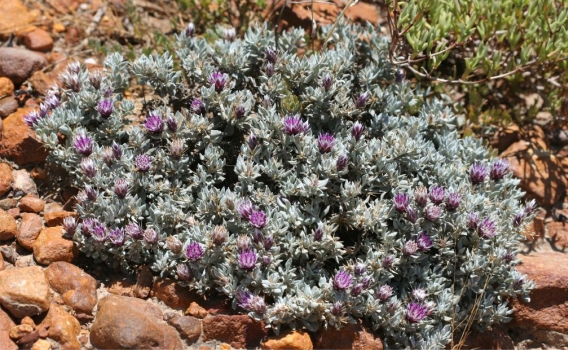
Description
Description
Shrublet up to 0.2 m high. Leaves are sessile, obovate up to 200 mm long, upper surfaces grey or green, pubescent becoming glabrous and lower surfaces are grey-felted, margins are usually slightly revolute but sometimes slightly toothed, apex acuminate and base attenuate. Flower heads are discoid (ray and marginal florets absent), solitary at branch tips, pink or white. Bracts glabrous, outer acuminate forming stout spines, up to 25 mm long and inner up to 10 mm long. Pappus of flat serrulate scales. Plants flower erratically in spring, summer, autumn or early winter, from September to June.
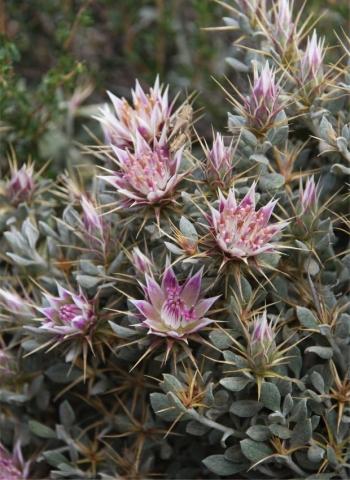
Conservation Status
Status
Macledium spinosum is currently listed as Least Concern (LC) in the Red List of South African plants.
Distribution and habitat
Distribution description
This species occurs from Du Toitskloof to Graaff-Reinet and from Willowmore to Grahamstown, on dry rocky shale slopes.
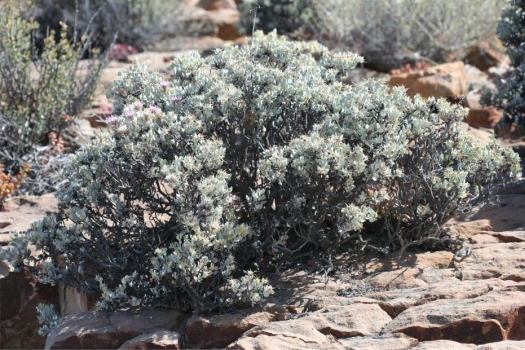
Derivation of name and historical aspects
History
The genus Macledium contains about 20 species occurring in tropical and southern Africa. The genus was described by Cassini in 1825 and reinstated by Ortiz in 2001, following a phylogenetic study of Dicoma and related genera (Ortiz 2000). The species previously belonging to sections of Macledium and Pterocoma of the genus Dicoma have been moved to Macledium by Ortiz (2001).

Ecology
Ecology
The seeds are dispersed by wind and favoured by insects.
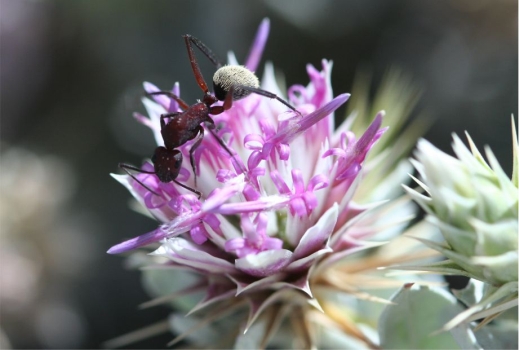
Uses
Use
No uses recorded, however some species in the genus are medicinally important. It can be an attractive garden plant, especially in drier areas.
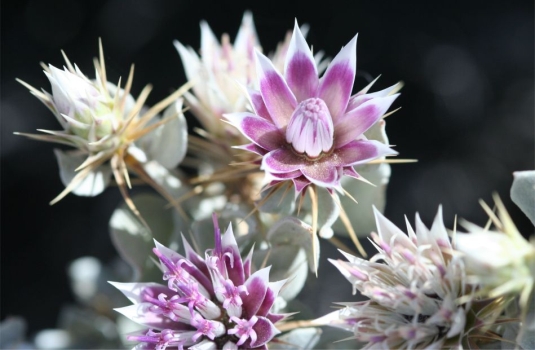
Growing Macledium spinosum
Grow
Cultivation requirements are not yet known, but the cultivation techniques suggested for other species in the genus, such as Macledium zeyheri, are likely to apply.
References
- Koekemoer, M. 2019. Macledium. In C.L. Bredenkamp, A Flora of the Eastern Cape Province. Strelitzia 41. Volume 1: 586. South African National Biodiversity Institute, Pretoria.
- Manning, J. & Goldblatt, P. 2012. Plants of the Greater Cape Floristic Region 1: the Core Cape Flora. Strelitzia 29. South African National Biodiversity Institute, Pretoria.
- Ortiz, S. 2000. A phylogenetic analysis of Dicoma Cass. And related genera (Asteraceae: Cichorioideae: Mutiseae) based on morphological and anatomic characters. Annals of the Missouri Botanical Garden 87 (4): 459–481.
- Ortiz, S. 2001. The reinstatement of the genus Macledium Cass. (Asteraceae, Mutiseae): morphological and phylogenetic arguments. Taxon 50(3):377–744.
- Raimondo, D., Von Staden, L., Foden, W., Victor, J.E., Helme, N.A., Turner, R.C., Kamundi, D.A. & Manyama, P.A. (eds) 2009. Red list of South African plants. Strelitzia 25. South African National Biodiversity Institute, Pretoria.
Credits
Thuli Makhoba
National Herbarium, Pretoria
May 2023
Acknowledgements: images by Marinda Koekemoer.
Plant Attributes:
Plant Type: Shrub
SA Distribution: Eastern Cape, Western Cape
Soil type: Sandy, Loam
Flowering season: Sporadic/All year
PH: Acid, Neutral
Flower colour: White, Pink
Aspect: Full Sun
Gardening skill: Average
Special Features:
Horticultural zones








Rate this article
Article well written and informative
Rate this plant
Is this an interesting plant?
Login to add your Comment
Back to topNot registered yet? Click here to register.